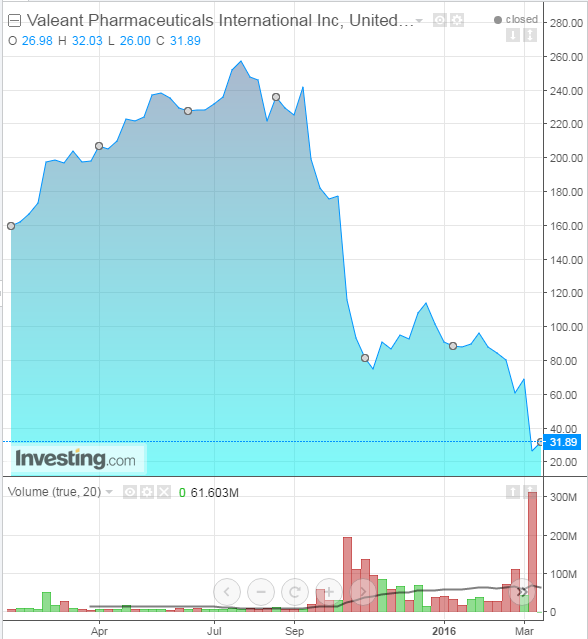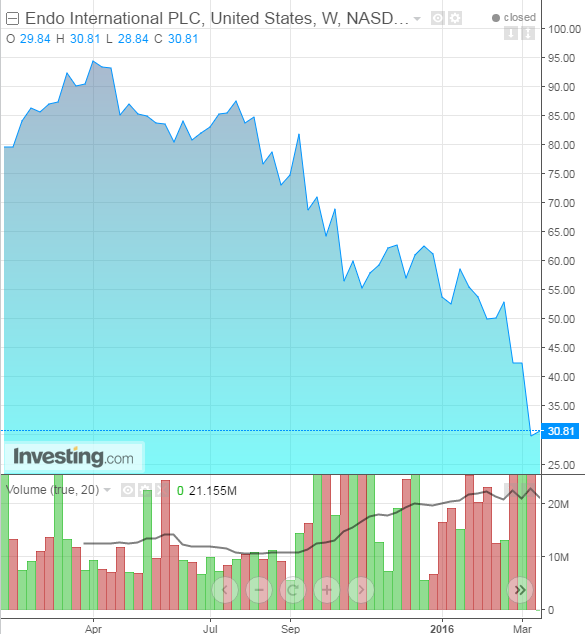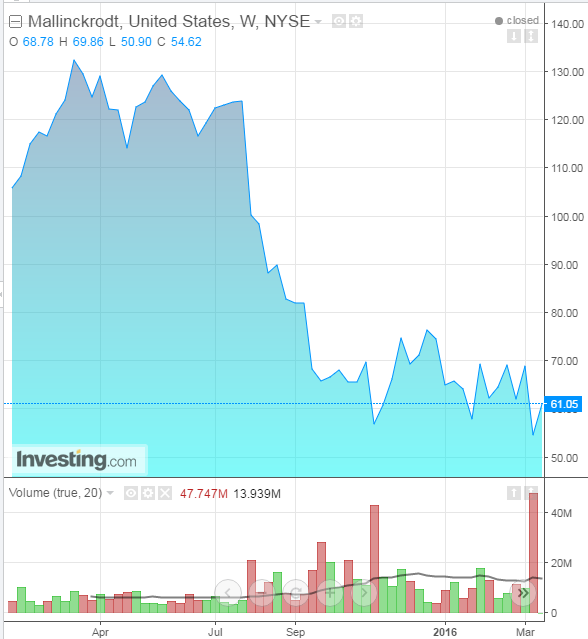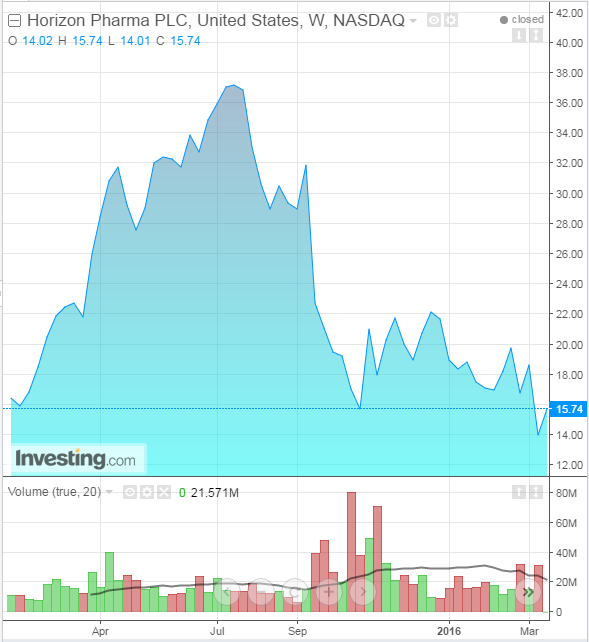by Clement Thibault
Recently we checked in with the Pharma sector, where the prevailing business model of spending (sometimes lavishly) on research and development in order to bring to market an exclusive blockbuster drug has long been (and remains) the industry standard. Recently, however, some specialty pharma companies—most notably and notoriously—Valeant Pharmaceuticals (NYSE:VRX), have tried a bit of disruption, using aggressive acquisitions and attendant steep price hikes to drive the business.
Valeant's ongoing collapse, in part due to the toxic PR accompanying its aggressive pricing policies, but perhaps as much due to its faulty business model, has pulled down an assortment of biotechs in its wake, as market participants seem to be fleeing the sector. When we published our original Pharma article, VRX was trading for $61.31 a share. Since then, on March 15, 2016, Valeant issued a downgraded outlook for 2016, lowering its expected annual EPS to around $9.5, down from $13.25-13.75. Moreover, CEO Michael Pearson claimed on the company's conference call that the company understands that "The world has changed", which probably means the end of operations under its current business model. Add to all that a $600 million "typo" in the company's press release concerning its expected future EBITDA, and you've got a real mess on your hands.

Unsurprisingly, the events of that day cut Valeant's value by as much as 51%, after it closed at $33.51. And the carnage isn't over.
As of yesterday, the stock is trading even lower, $31.89 at close. A potential recovery will be possible but only if Valeant is able to regain the public's trust. But firing CEO Pearson and naming investor Bill Ackman to the board has not stopped the bleeding. With $30B dollars in long term debt and a business model that has now crashed and burned, it's hard to see Valeant ever returning to its mid-2015 high of $263.81.
So is the specialty pharma sector finished? Or is it just Valeant's business model that needs to be scrapped?
A few other, strikingly similar companies have been dragged down by Valeant. Horizon Pharma PLC (NASDAQ:HZNP), Endo International PLC (NASDAQ:ENDP) and Mallinckrodt (NYSE:MNK) have all lost well over 50% in the past six months.
Endo stood at $88.54 in August, and now trades at $30.81, down 65%.

Mallinckrodt, which traded for $125.85 in August, is now at 61.05, down 54%.

Finally, Horizon fell from $37 to, as of yesterday's close, $15.74, 57% less than what it used to be.

For each company mentioned above, losses are primarily due to the fact that their ongoing strategies of mergers and acquisitions mirror the model Valeant relied on. But should each of these companies be tarred with the same brush?
In Valeant's case the damage from this business model is glaringly apparent in the company's balance sheets and income statements. Valeant's long term debt jumped from $10.5 to $30 billion dollars, while its R&D investment grew by a mere $40 million, to a total of $96 million. In comparison, Pfizer (NYSE:PFE) spends about 2 billion annually in R&D – 50 times the amount VRX allocated.
Endo International's long term debt has grown from $3 to 8 billion dollars, following acquisitions of five pharmaceutical companies in 2013-2014 alone. Its focus on M&A is obvious from its slim R&D costs—just $44 million.Similarly, Horizon has added $1.1 billion of long term debt to its balance sheet, while at the same time spending only $13 million on R&D.
The numbers seemingly implicate Mallinckrodt as well, which, from just $9 million of long term debt in 2012 now owes a whopping $6.5 billion. And over the same period, its R&D costs rose only about 30%—from $144 to $185 million. Even though Mallinckrodt's CEO tried to differentiate his company from Valeant, we'd rather pay attention to the numbers.
While each of the three companies might be similar to VRX in some ways, each is not even close to the same amount of of trouble currently bringing down Valeant. VRX's long term debt-to-equity ratio is 4.75, meaning the company owes 4.75 times as much money as the value of its market cap. The ratios for Endo, Horizon and Mallinckrodt aren't even close at 1.38, 0.9 and 1.23, respectively. That’s not to say each is financially sound since all are still very indebted, but so are most pharma companies which first spend on development and then recoup when introducing a winner.
Looking ahead, it's our assessment that each of these three companies is probably better positioned to re-adjust course, now that the pricing party has ended; And if any aren't willing to do it voluntarily, – the FDA might have to step in. Another factor in favor of each of these three smaller companies: they have less debt to serve, and have managed to avoid the crushing public wrath now being heaped on Valeant (and on Martin Shkreli and his company, Turing Pharmaceuticals, beforehand).
While HZNP, ENDP and MNK have obviously been connected to the Turing/Valeant mess, we view their situations more along the lines of collateral damage, and believe they have just momentarily fallen out of favor with investors, making them potential value buys as the dust settles. This hypothesis is supported by the joined, upward movement of the stocks this week, when the unrelated firing of Valeant's Pearson led to gains for Horizon and Mallinckrodt.
The specialty pharma market is burning right now, and related price movements are out of sync with actual performance or future outlook. Of course, we don't recommend blindly buying into specialty pharma (nor anything else, for that matter), but a little time spent on due diligence might reward the bold with double digit gains once the fires subside.
